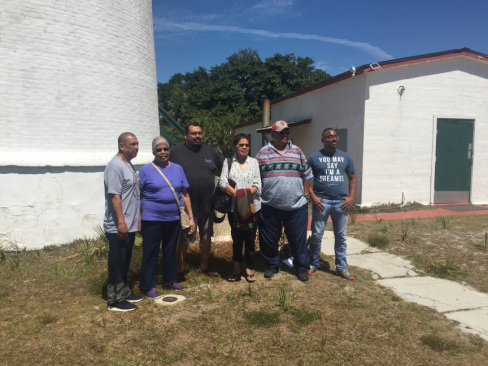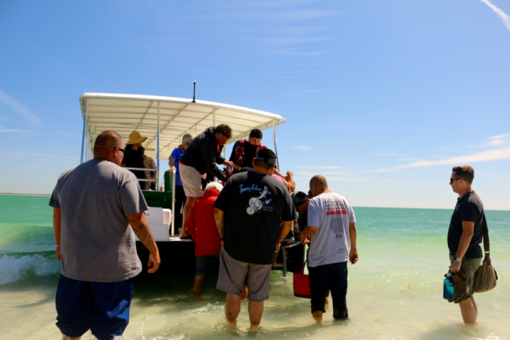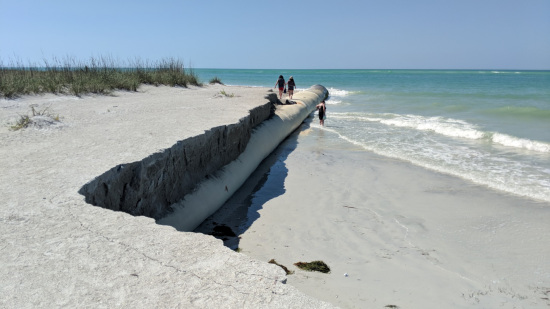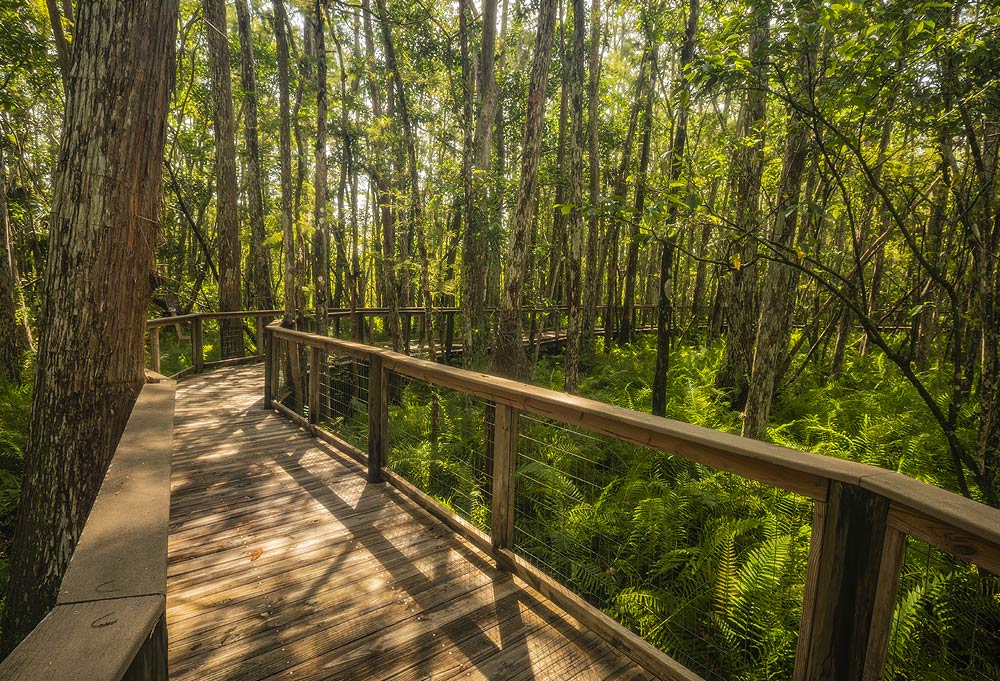
Tribal Perspectives on Sea Level Rise and the Costs of Preservation at Egmont Key
By Nick Butler
Sea level rise in Florida is a real thing and is currently affecting thousands of significant sites along the coast. One site, Egmont Key, has been investigated by the THPO and may likely be completely underwater within the next 100 years. With the incoming tide of sea level rise, it is imperative that we capture the importance of this site and the gravity it carries in Tribal history.

Figure 1. Map of Egmont Key’s receding shoreline over the past 100 years.
In 1877, Egmont Key, an island located at the mouth of Tampa Bay, was approximately 580 acres in size. Over 100 years later, the island is just barely over 200 acres, as a result of erosion and sea water rising 4-8 inches in that time period. The Gulf of Mexico is swallowing up Egmont Key before our eyes. For the Seminole Tribe of Florida (STOF) and its members, Egmont Key represents the struggle between the necessity of preservation for future generations and the costs of those protections. Without immediate intervention, the island will only be a memory.

Figure 2. A testament to Polly Parker’s tenacity, six of her descendants journey back from the prison she escaped.
During the Third Seminole War, Egmont was employed as a concentration camp. Tribal Members have often likened Egmont to “our Auschwitz.” It’s a place of death, a crucible that serves as a memorial for Tribal members’ ancestors’ ability to endure the grimmest of hardships. As tribal member Rita Youngman explains, “Egmont Key is an important place since it is a reminder about how the Seminoles went on to survive one of the darkest periods in U.S. history.”
Tribal Members want action. It is their history to care for. “Whatever they can do, I want it preserved. Like they said, this is where she [Polly Parker] was. It’s like y’all said, we are losing sand and trying to get help with that, mainly,” said Nancy Willie. She is a descendant of Polly Parker, a significant Seminole figure who escaped capture while on the Seminole’s Trail of Tears and eventually made her way back home to south Florida.
Mrs. Willie, along with others, has only begun their journey into investigating ancestral heritage and the grave history of Egmont Key for the Seminole Tribe of Florida. She decided to make the trek to from the Hollywood Reservation on the latest community trip this past April.
On April 5th, 2018 twenty-five to thirty members of the Seminole Tribe of Florida gathered from the Brighton, Big Cypress, and Hollywood Reservations to wait on a little ferry at a beach in Fort De Soto Park which is located just outside the mouth of Tampa Bay. Reaching later in life, Nancy Willie wishes to know more about the story of Polly Parker and others, so that she may share that knowledge with her children. If the island were to vanish, a vital touchstone to the Seminole ancestors would disappear with it.
Field trips have been successful for the purposes of educating members about the imminent challenges that are endangering Egmont Key. On these trips, they have the opportunity to witness for themselves the progressive deterioration, and it allows for the THPO to create a dialogue with the community.
Kevin Holata, a tribal member, shared his feelings about Egmont Key’s painful past. “It is a sensitive story and some tribal members may be hurt, but it’s about our history and it needs to be known.” There have been strides to keep the island intact. The U.S. Army Corps of Engineers successfully completed two beach re-nourishment projects which used dredged material from the Egmont Canal. But is it enough to stave off the growing consequences of climate change?

Figure 3. April 5th field trip, Tribal members and THPO staff embarking onto the shores of Egmont Key.
In an “intermediate” scenario by 2060, waters will rise approximately to 2 feet (0.6 meters) which will inundate over half of the island. From https://coast.noaa.gov/digitalcoast/tools/slr
The Tribe cannot be alone in this fight. The U.S. must step up its commitment to renewable energy. It has to further invest in environmental sustainability to combat “accelerated-climate change” from human activity by utilizing alternative forms of energy. It should be a global effort. As Mr. Frank points out, “What it gets down to is, yes, America and the whole world has to do a better job utilizing solar energy. I think there are a lot of countries that jumped on the bandwagon, and the United States just has happened to be dragging butt right now, kind of last in line.” Not only would these long-term investments help protect sites like Egmont Key, but communities living along the edges of the coasts of the United States could take a sigh of relief.

Figure 4. Screenshot of NOAA’s Sea Level Rise Prediction Model.
In the summer of 2017, Hurricane Irma came barreling across the state, wreaking massive damage to Florida’s coasts, uprooting millions of Floridians from their homes. At Egmont Key, gusts of up to 91 miles per hour were recorded at the weather station located on the island. Structures that were once covered by beachy white sand now lay bare from hurricane force winds. Artifacts previously located during archaeological fieldwork have now been displaced from wind erosion.
Joe Frank, STOF BC Board Representative noted other communities all across the state have felt or will feel the harsh reality of “accelerated-climate change”, as evidenced by rising waters, beach erosion, and intensifying hurricanes. Among these issues, sea-level rise will surely be a herculean challenge in the years to come as waters encroach on shorelines. They will eventually inundate places of cultural and historical significance along the coasts. Places such as Miami Beach are already dealing with flooding during high tides.
Joe Frank, STOF BC Board Representative noted other communities all across the state have felt or will feel the harsh reality of “accelerated-climate change”, as evidenced by rising waters, beach erosion, and intensifying hurricanes. Among these issues, sea-level rise will surely be a herculean challenge in the years to come as waters encroach on shorelines. They will eventually inundate places of cultural and historical significance along the coasts. Places such as Miami Beach are already dealing with flooding during high tides.
Thousands of sites are threatened. Based on data from the Florida Master Site File (a registry of all cultural sites in Florida), a simple increase of three feet of ocean waters from current levels will impact 16,015 cultural sites; a further increase to six feet of sea-level rise will impact 34,786 culturally significant sites. Sites like these are valuable teaching tools that not only remind us of past social injustices committed, but can also instruct us on the future of the planet. “In the normal ebb and flow of human civilizations, when you have to rebuild,” says Mr. Frank, speaking on imminent impacts of cultural sites, “it’s best to know what they tried in the past, so you don’t end up making the same mistakes again.”

Figure 5. In the aftermath of Irma, beach sand washed out into the Gulf uncovering an underground sand barrier to help slow down erosion at Egmont Key.


